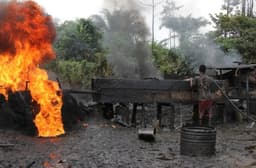
President Tinubu
While Nigeria retained its position in the LMIEs, some African countries like Algeria, Botswana, Equatorial Guinea, Gabon, Libya, Mauritius and South Africa are placed higher among the Upper Middle Income Economies (UMIEs).
The World Bank stated that for the current 2026 fiscal year, low-income economies are defined as those with a Gross National Income (GNI) per capita calculated using the World Bank Atlas method of $1,135 or less in 2024.
However, the middle income GNI per capita include countries of between $1,136 and $4,495; upper middle-income economies are those with a GNI per capita between $4,496 and $13,935 and high-income economies are those with more than a GNI per capita of $13,935.
The World Bank Group said that its income classifications provide valuable insights into global economic trends and development progress.
“As countries continue to evolve economically, these classifications will remain crucial for shaping development policies and strategies. Policymakers should consider these classifications when designing economic policies and strategies.
“Understanding the factors influencing income classification can guide efforts stimulating economic growth, help manage inflation, and enhance integration into the global economy,” it said.
Nigeria was also listed among countries in fragile and conflict affected situations alongside Yemen, Ukraine, Gaza, West Bank, Sudan, South Sudan, Somalia, Syria, Niger, Burkina Faso and Afghanistan among others. However, Nigeria was not included in the list of heavily indebted poor countries, which included Rwanda, Ghana, Gambia, Liberia, amongst others.
The World Bank said that the shifts in income classification varied significantly across regions, with for instance, 26 per cent of countries in East Asia and Pacific being low-income in 1987 , but by 2024, only 3.0 per cent remained in this category.
Europe and Central Asia had no low-income countries in both 1987 and 2024, although they had a slight decrease in high-income countries from 71 per cent to 69 per cent.
Low-income countries in Latin America and the Caribbean reduced from 2.0 per cent in 1987 to zero in 2024, while high-income countries increased from 9.0 per cent to 46 per cent.
However, low income countries increased from two to three in the Middle East and North Africa while high-income countries rose to 35 per cent. All countries moved from low-income in 1987 to lower-middle- and upper-middle-income by 2024 in South Asia.
In Sub-Saharan Africa, low-income countries decreased from 75 per cent to 45 per cent, with only one country, Seychelles, reaching high-income status.
The updated country income classifications for FY26, based on the Atlas GNI per capita of 2024, revealed shifts due to changes in Atlas GNI per capita and classification thresholds.
“These thresholds are adjusted annually for inflation using the Special Drawing Rights (SDR) deflator. Often the thresholds go up with this adjustment, however occasionally, including this year, the thresholds have moved down slightly due to the appreciation of the U.S. dollar vs. other currencies,” the World Bank added.
Namibia was the only country whose classification moved downward this year, from the “upper-middle income” to the “lower-middle income” category.
In 2024, Namibia’s Gross Domestic Product (GDP) grew 3.7 per cent, a 0.7-point deceleration from 2023, while inflation based on the GDP deflator slowed from 6.6 per cent in 2023 to 3.3 per cent in 2024.
One of the main factors behind the slower GDP growth was a sharp deceleration in mining and quarrying, for which growth went from +19.3 per cent in 2023 to -1.2 per cent in 2024 due to weak demand for diamonds. (THISDAY)



























NEWS EXPRESS is Nigeria’s leading online newspaper. Published by Africa’s international award-winning journalist, Mr. Isaac Umunna, NEWS EXPRESS is Nigeria’s first truly professional online daily newspaper. It is published from Lagos, Nigeria’s economic and media hub, and has a provision for occasional special print editions. Thanks to our vast network of sources and dedicated team of professional journalists and contributors spread across Nigeria and overseas, NEWS EXPRESS has become synonymous with newsbreaks and exclusive stories from around the world.